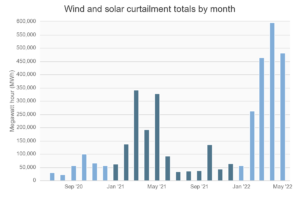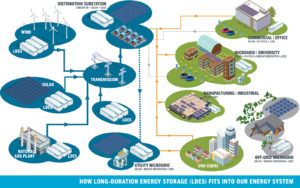By Eric Dresselhuys, CEO
Governor Newsom’s proposed budget has the potential to deliver reliable power and long-term cost savings to energy consumers.
In California, high energy costs and unreliable electricity have become the norm. Fortunately, new long-duration energy storage (LDES) technologies will soon be able to store large quantities of energy from wind and solar generators and deploy it for longer periods – from 8-12 hours – to provide cost-effective power to the grid even when the sun is not shining or the wind is not blowing. With increased LDES, it will be possible to fully leverage the state’s growing solar generation capacity and deliver clean energy around the clock.
There is a huge opportunity to capture and use wasted solar energy in California. In 2021, the state curtailed approximately 1.5 terawatt hours of clean energy – enough energy to power over 218,000 homes for a year. And this trend is accelerating as solar generation grows. In the first four months of 2022, California effectively wasted 1.38 terawatt hours of renewable energy because it had nowhere to go at the time it could have been generated.

California Independent System Operator (CAISO)
Capturing and using that excess solar energy can not only reduce costs and provide more reliable power, it can reduce or eliminate the need for peaking fossil fuel plants, backup diesel generators, or even worse, rotating power outages.
California has already deployed some grid-scale energy storage, however to date, this has mostly consisted of lithium-based batteries. Lithium technology will continue to play a central role in America’s clean energy future – it is a good solution for short duration energy storage needs and for electric vehicles. But, in addition to being better suited to short duration storage, lithium battery growth faces challenges from a narrow lithium supply chain, the environmental and ethical hazards of mining and sourcing necessary critical minerals, and the real fire dangers posed by lithium-ion battery operations.
New LDES technologies, such as the iron flow batteries manufactured by ESS, provide an opportunity to expand energy storage without the supply chain and operational constraints posed by lithium. With iron flow technology, raw materials are earth abundant and can be domestically produced. The batteries are non-toxic, non-flammable, and have a design life of 25 years – more than twice the lifespan of lithium-ion batteries. Iron flow technology was first pioneered by NASA and the safety and reliability profiles are well established. With scale, they will help lower the cost of safe, reliable renewable energy even more. This isn’t theoretical. Projects are already in development which incorporate iron flow technologies to help address California’s energy challenges. As part of its effort to reduce the risks and impacts of public safety power shutoffs (PSPS), a utility in California is installing a solar and iron flow microgrid that will power critical community facilities including emergency services, a healthcare center and a school during PSPS events. When not supporting a PSPS event, the iron flow batteries will deliver stored renewable energy back to the grid as the sun goes down.

California’s energy vision and long-term investments helped create a mass market for solar energy, and thus dramatically lowered costs. By creating a mass market for long-duration energy storage, the state can leverage and maximize that investment while lowering costs for customers and improving reliability – and of course protecting our climate.
Governor Newsom recently allocated $388 million in his current budget to provide seed money for new long-duration energy storage technologies. The addition of long-duration energy storage will create multiple benefits for California in the future. By 2045, LDES could enable the retirement of 10 GW of fossil fueled generation, reduce system capacity costs by $1.5 billion per year, increase renewable energy utilization by 17%, and reduce in-state use of fossil fuels for electricity generation by 25%.
Governor Newsom’s proposal has the potential to drive forward the energy transition and make California’s energy grid a model for the rest of the world by creating a truly sustainable, reliable, low-carbon energy system.
Links to third-party articles and/or websites are for general information purposes only and the content of any third-party article or website is solely the responsibility of the author, owner, operator or publisher of that article and/or website. Views expressed in third-party articles and/or websites reflect the opinion of the author, owner, operator or publisher as of the date of publication, and not necessarily those of ESS Tech, Inc. ESS Tech, Inc. has not independently verified such content, makes no warranties, representations or undertakings relating to such content, and bears no responsibility for the accuracy, legality or content of any external site or for that of subsequent links. Any reliance you place on such information is strictly at your own risk. You are encouraged to read and evaluate the privacy and security policies on the specific site you are entering. ESS Tech, Inc. disclaims any loss, damage and any other consequences resulting directly or indirectly from or relating to your access to the third-party website or any information you may provide or any transaction conducted on or via the third-party website or the failure of any information, goods or services posted or offered at the third-party website or any error, omission or misrepresentation on the third-party website or any computer virus arising from or system failure associated with the third-party website.

